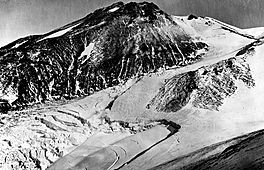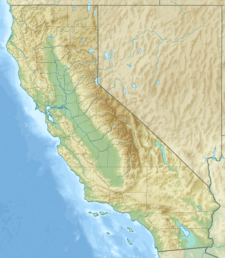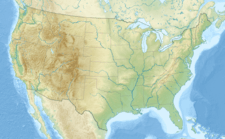Whitney Glacier facts for kids
Quick facts for kids Whitney |
|
|---|---|
 |
|
| Type | Mountain glacier |
| Location | Mount Shasta, Siskiyou County, California, United States |
| Coordinates | 41°24′50″N 122°12′41″W / 41.41389°N 122.21139°W |
| Area | .5 sq mi (1.3 km2) |
| Length | 2 mi (3.2 km) |
| Thickness | 126 ft (38 m) in 1986 |
| Terminus | Moraine |
| Status | Expanding |
The Whitney Glacier is a huge river of ice found on Mount Shasta in California, USA. It's special because it's the longest glacier in California. It's also the only "valley glacier" in the state, meaning it flows down a valley like a river.
Even though it's the longest, it's the second largest in total size and amount of ice. The nearby Hotlum Glacier is bigger. Back in 1986, the Whitney Glacier was measured to be about 126 ft (38 m) deep. That's like a 12-story building! It was also over 3 km (1.9 mi) long.
The glacier starts high up on Mount Shasta's Misery Hill, at an elevation of about 13,700 ft (4,200 m). From there, it slowly flows northwest. It moves down towards the dip, or "saddle," between Mount Shasta and another peak called Shastina.
As it flows, the ground gets bumpy, which creates a big "icefall" at about 11,800 ft (3,600 m). An icefall is like a frozen waterfall, where the ice cracks and breaks as it moves over steep, uneven ground. After the icefall, the glacier continues to flow down the valley between the two peaks. Its end, called the "terminus," is found between 9,500 to 9,800 ft (2,900 to 3,000 m).
How Whitney Glacier is Growing
In 2002, scientists took a close look at Mount Shasta's glaciers. It was the first detailed study in 50 years. They discovered something surprising: seven of the glaciers had actually grown bigger between 1951 and 2002!
The Hotlum Glacier and Wintun Glacier nearly doubled in size. The Bolam Glacier grew by half, and the Whitney and Konwakiton Glaciers got about a third bigger. This is unusual because many glaciers around the world are shrinking.
Why is it Growing?
Scientists found that even though the area's temperature went up a little (about two to three degrees Celsius), there was also a lot more snowfall. It seems that warmer temperatures pulled more moisture from the Pacific Ocean. This led to heavier snowfalls.
This extra snow falls in the "accumulation zone" of the glacier. This is the upper part where snow builds up faster than it melts. The study showed that this zone received 40 percent more snowfall than what melted away in the "ablation zone." The ablation zone is the lower part of the glacier where ice melts faster than snow falls.
So, over 50 years, the Whitney Glacier actually expanded by 30 percent. This is the opposite of what's happening with most glaciers globally.
What About the Future?
Researchers also thought about what might happen next. They said that if global warming predictions for the next 100 years are correct, the increased snowfall might not be enough. The warmer temperatures could cause too much melting. If that happens, the Whitney Glacier would likely start to shrink instead of grow.
The Whitney Glacier, along with the Hubbard Glacier in Alaska, are bigger now than they were in 1890. The Hubbard Glacier is a "calving glacier," which means huge chunks of ice break off into the sea.



